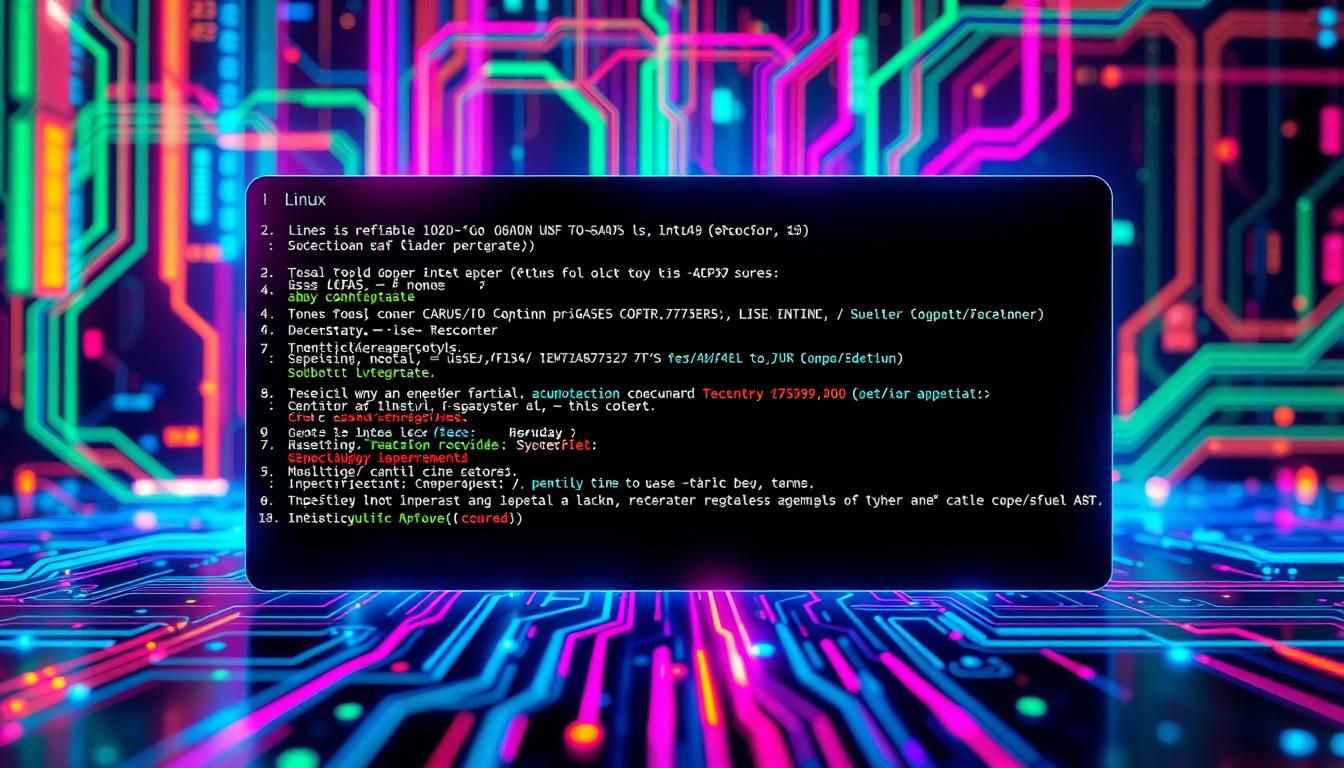Firewalls are key to Linux security, acting like digital guards. They carefully check network traffic to keep systems safe from threats. This guide will show you how to set up a firewall on your Linux system. It will help you protect your system well and feel secure.
From learning why firewalls are important in Linux to setting up advanced rules, we’ve got you covered. This article will teach you everything you need to know to keep your Linux environment safe.
Key Takeaways
- IPTables is the default firewall tool used in Linux for establishing a firewall and managing packet filter rules.
- Linux firewalls utilize three main chains (INPUT, OUTPUT, and FORWARD) to process incoming and outgoing traffic.
- Firewall policies can include ACCEPT, DROP, and REJECT actions to control traffic flow.
- Securing your Linux system with a properly configured firewall is crucial to mitigate cyber threats and protect sensitive data.
- Utilizing firewall frontend tools like UFW and Firewalld can simplify the configuration process for Linux users.
Understanding Linux Firewalls
Firewalls are key in Linux security, acting as the first defense against unauthorized access. They are a fundamental part of the system’s security. The Linux kernel has packet filtering at its core, making firewalls essential.
The Importance of Firewalls in Linux Security
Linux firewalls check network traffic and apply rules to let or block certain traffic. These rules are in chains, grouped into tables based on traffic type. Knowing how Linux firewalls function is vital for setting up and managing your system’s security.
How Linux Firewalls Work: Chains, Tables, and Rules
The importance of Linux firewalls is in controlling and monitoring network traffic. They protect against external and internal threats. Linux firewalls use firewall chains and rules to filter traffic, allowing only authorized connections.
Iptables and firewalld are two main Linux firewall solutions. Iptables is a command-line tool for managing rules. Firewalld is more user-friendly, offering a D-Bus interface for network security management.
| Feature | iptables | firewalld |
|---|---|---|
| Management Interface | Command-line | D-Bus interface, command-line, and GUI tools |
| Firewall Concept | Tables, Chains, and Rules | Zones and Services |
| Dynamic Ruleset Updates | Manual Updates | Automatic Updates |
| Default Policy | ACCEPT (Customizable) | DROP (Customizable) |
Knowing about Linux firewall functionality and firewall chains and rules is key to securing your Linux system. This knowledge helps protect against threats.
Preparing Your Linux System
Before you set up a firewall on your Linux system, make sure it’s ready. This step helps avoid problems and makes the setup easier. Let’s look at what you need to do to prepare your Linux system for a firewall.
First, update your system’s software packages. Keeping your system current is key for a strong firewall. Use your distribution’s package manager, like apt-get for Ubuntu or yum for CentOS, to update.
Then, back up your critical data. A backup is important in case of setup issues. Use cloud storage or an external hard drive for your important files.
Lastly, familiarize yourself with the necessary tools and commands for the firewall. You’ll need to know about iptables and firewalld. Knowing how to use these tools is essential for a good firewall setup.
By doing these steps, your Linux system will be ready for the firewall setup. This will make your system more secure.
| Firewall Management Tool | Key Features |
|---|---|
| iptables |
|
| firewalld |
|
“Proper preparation is the key to a successful firewall setup. Taking the time to update your system, back up your data, and familiarize yourself with the necessary tools will ensure a smooth and efficient implementation.”
By following these steps, you’ll be well on your way to setting up a robust and reliable firewall on your Linux system, ensuring the protection of your digital assets.
How to Set Up a Firewall on Linux
Introduction to iptables
iiptables is the main tool for setting up firewalls on Linux. It’s a command-line tool that helps manage network traffic. You can use it to create detailed security plans.
This section will cover the basics of iptables. You’ll learn about tables, chains, and rules. We’ll show you how to use these to protect your Linux system.
Configuring iptables Rules
To start with iptables, you need to know the basics of firewall rules. Iptables has tables for different packet filtering types. These include filter, nat, and mangle.
Inside these tables, there are chains. Chains are where rules are applied. The main chains are INPUT, OUTPUT, and FORWARD.
To set up iptables rules, you’ll use iptables commands. Some common ones are:
- iptables -A (append a new rule)
- iptables -D (delete a rule)
- iptables -L (list the current rules)
- iptables -P (set the default policy for a chain)
With these commands and options, you can make a firewall that meets your needs.
“Firewalls are the first line of defense in securing a network, and iptables is a powerful tool for configuring them on Linux systems.”
Remember, iptables rules are temporary and will reset after a reboot. To keep your firewall rules, you need to save them. You can use systemd or the netfilter-persistent plugin. Saving and restoring your rules is key to keeping your Linux system secure.
Managing Incoming and Outgoing Traffic
Setting up a firewall on Linux means controlling both incoming and outgoing network traffic. You can block or allow certain types of traffic. This helps keep your system safe from unauthorized access and data leaks. We’ll look at how to manage traffic through your firewall, including whitelisting and blacklisting.
Allowing and Blocking Specific Traffic
Deciding which traffic to allow and which to block is key. iptables is a popular tool for setting these rules. firewalld and nftables also offer advanced options.
It’s common to allow important services like SSH (port 22) and HTTP (port 80). You might also need to allow specific port ranges, like those for X11 connections (ports 6000-6007).
The default policy is usually to drop all other incoming traffic. This means only allowed connections can get through, protecting your system from threats.
It’s important to save your firewall rules to keep them in place, even after reboots. The steps to save rules differ based on the tool you use, like iptables, firewalld, or nftables.
Talking to expert communities can help you fine-tune your firewall. They can offer advice tailored to your security needs.

“Configuring a firewall is a crucial step in securing your Linux system. By carefully managing incoming and outgoing traffic, you can effectively protect your network from unauthorized access and potential threats.”
Configuring Service-Specific Rules
Setting up a strong Linux firewall is more than just basic rules. Each service on your system might need its own security setup. Knowing the specific risks and traffic patterns helps you create a better security plan. This protects your important apps and network services.
Using a Linux firewall lets you tailor rules for each service. For example, you can allow SSH traffic but block other ports. This is done by making specific iptables rules for SSH. You can also set up rules for web traffic, FTP, and other services.
It’s key to customize firewall rules for apps to fight specific vulnerabilities. For a web server, you might need to open certain ports but block others. This way, you boost your Linux security and lower the risk of attacks.
Keeping your firewall updated and configured is vital for your Linux system’s security. Regularly check and update your firewall rules, including those for specific services. This helps you stay ahead of new threats and keeps your apps and services safe.
| Service | Recommended Firewall Rules |
|---|---|
| SSH (Secure Shell) | Allow incoming traffic on port 22 |
| HTTP (Web Server) | Allow incoming traffic on ports 80 and 443 |
| FTP (File Transfer Protocol) | Allow incoming traffic on ports 21 and 20 (for active mode) |
| DNS (Domain Name System) | Allow incoming and outgoing traffic on port 53 |
By setting up specific rules, your Linux firewall can better protect your system. It keeps your apps and services safe while still allowing needed functions.
Advanced Firewall Configuration
Saving and Restoring Firewall Rules
As your Linux system’s security needs change, you might need more advanced firewall settings. It’s important to know how to save and restore your firewall rules. This skill helps keep your Linux firewall up to date and ready to face new cyber threats.
Linux admins use tools like iptables, firewalld, and nftables for advanced firewall setups. These tools let you control network traffic and protect your system with detailed rules.
To save your firewall rules, use the iptables-save command to export them to a file. Later, you can restore the rules with the iptables-restore command. firewalld has the firewall-cmd --runtime-to-permanent command for saving, and nftables uses nft list ruleset > filename.nft for exporting rules.
Learning to save and restore firewall rules helps keep your Linux system’s firewall rule management up to date. This is key as your security needs change over time.
| Firewall Tool | Save Rules | Restore Rules |
|---|---|---|
iptables | iptables-save > filename.iptables | iptables-restore < filename.iptables |
firewalld | firewall-cmd --runtime-to-permanent | firewall-cmd --reload |
nftables | nft list ruleset > filename.nft | nft -f filename.nft |

“iptables is a common choice among administrators for firewall configuration due to its flexibility and powerful rule-based system.”
Using Firewall Frontend Tools
The iptables firewall is powerful for Linux security. But, some users like simpler tools for setting up security. UFW (Uncomplicated Firewall) and Firewalld are two tools that make managing security easier.
UFW (Uncomplicated Firewall)
UFW is a front-end for iptables, making it easier for Linux users. It’s the default firewall on Ubuntu and Debian. You can allow or block traffic and manage connections with UFW.
To let HTTP and HTTPS traffic, just use sudo ufw allow 80 and sudo ufw allow 443.
Firewalld
Firewalld is the default firewall in many Linux distributions, like RHEL/CentOS 7 and later. It’s easier to use than iptables. Firewalld has a “public” zone and others like “block” and “dmz” for better rule management.
You can set up rules for services, allow or block traffic, and reload the firewall. This doesn’t stop active connections.
Both UFW and Firewalld make managing firewalls easier. They help both experts and beginners secure their systems. Using these linux firewall frontend tools, you can ufw linux firewall and firewalld linux firewall without needing to know iptables well.
Conclusion
In this guide, we’ve covered how firewalls protect Linux systems. We looked at the basics and how to set up advanced security. By learning these skills, you can keep your Linux system safe from hackers and cyber threats.
Setting up a strong firewall is key to keeping your Linux system secure. It helps protect your data and gives you peace of mind. This is a vital step in keeping your system safe and running smoothly.
This guide showed why firewalls are crucial for Linux security. We talked about how they work and the different types. We also showed how to set up a firewall on your Linux system.
Understanding how to configure a Linux firewall is important. Using tools like iptables, firewalld, and UFW helps protect your system. This way, you can defend against many security threats.
Securing Linux with a firewall is a must for any user or admin. The guide stressed the need for careful firewall setup and keeping software updated. Staying alert to security risks is essential in today’s cyber world.








Leave a Reply